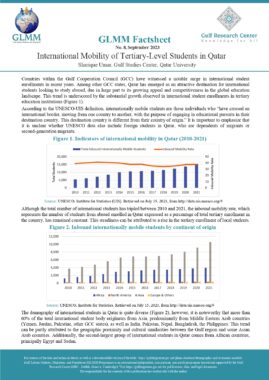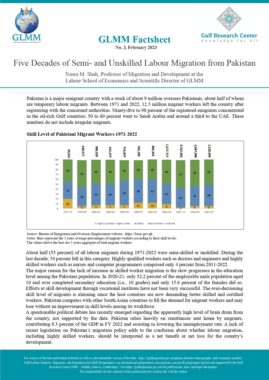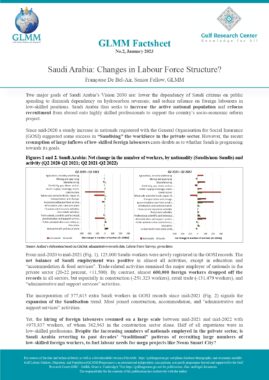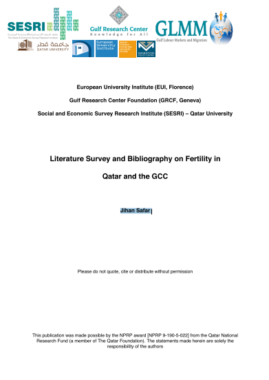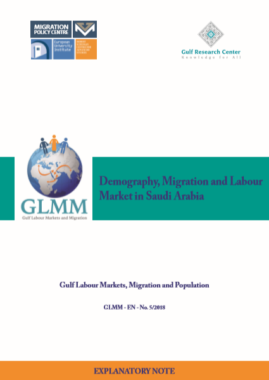Qatar: Population by nationality (Qatari/ non-Qatari) at dates of census (1970-2020)
| Census | Qataris | Non-Qataris | Total |
| 1970 | 45,039 | 66,094 | 111,133 |
| 1986 | 99,754 | 273,638 | 373,392 |
| 1997 | 151,673 | 384,801 | 536,474 |
| 2004 | 192,586 | 605,475 | 798,061 |
| 2010 | 243,073 | 1,456,362 | 1,699,435 |
| 2015 | 301,342* | 2,103,434* | 2,404,776 |
| 2020 | NA | NA | 2,846,118 |
Source: MDPS/ PSA and GLMM calculations on the basis of QSA/ MDPS data
* GLMM’s estimate, based on data published by the Planning and Statistics Authority (see below).
ANNEXED NOTE
- Technical Notes and Definitions
Reference periods for each census:
1970: unknown; the nights of March 16th, 1986; March 1st, 1997; March 16th, 2004, April 21st, 2010; April 20th, 2015; December 2020.
Implementation method: de facto, as well as de jure methods (1986-2015)
Census 2020 was based on administrative records, supplemented by an online self-enumeration platform, completed with field enumeration.
Population of reference: all individuals (nationals and non-nationals), present within the country’s borders during night of reference.
– Populations away from usual residence in Qatar for reasons of duty, or on a visit abroad for less than two months, as well as individuals with no personal housing within Qatar staying with a household for more than two months, are counted in their usual/ present residence during census night.
– Populations in transit or visiting Qatar as tourists, as well as residents of public housing or visitors staying in a household for less than two months after night of reference were excluded.
Prior to census 2010, only a sample of foreign residents was covered in censuses.
2015: No population data broken down by nationality was published, based on census results.
We estimated the numbers of Qataris and non-Qataris, using:
- 2015 Labour Force Survey (Q2): Figures of population aged 15 and above, by nationality (period of reference: mid-2015)
Sampling frame of LFS 2015: Population Census 2010.
Sample size: 44,756 persons, in 6,953 households: 1- Qatari households; 2- Non-Qatari regular (non-collective) and collective households;
Reference period for the labour force data: the week prior to data collection day.
Population of reference: all Qatari and non-Qatari households present in Qatar on the night of survey, living in normal and collective households.
- PSA. Women and Men in the State of Qatar- A Statistical Profile, Doha: PSA, 2016.
Figures of population aged 0-14 by nationality (national/ non-national) and sex (period of reference: mid-2015).
The figures of Qataris and non-Qataris by sex were then estimated on the basis of the percentage distribution of population by broad age groups, sex and nationality for mid-2015 (Table 1/3, p. 18).
The figures of Qataris and non-Qataris at the time of census were then calculated, using:
-the ratio of nationals and non-nationals calculated for mid-2015.
-the total figure of the population residing in Qatar during census 2015’s date of reference.
2020: Figures of total population broken down by nationality (Qataris and non-Qataris) are not readily available in any census publication.
No alternative, recent enough source was available as of 20 October 2022, to calculate a reliable estimate of the national and non-national populations at the time of census.
- Institution which provides data
Ministry of Development Planning and Statistics (MDPS)
currently: Planning and Statistics Authority (PSA)
(https://www.psa.gov.qa/en/Pages/default.aspx)
- Data availability
Released parts of censuses (1986; 1997; 2004; 2010, 2015), as well as some analytical volumes, are available on the website of the PSA, in PDF format.
https://www.psa.gov.qa/en/statistics1/StatisticsSite/Census/Pages/default.aspx
Census 2020′ website:
https://www.psa.gov.qa/en/statistics1/StatisticsSite/Census/Census2020/Pages/default.aspx;
https://www.psa.gov.qa/ar/statistics1/statisticssite/census/census2020/pages/default.aspx
Detailed results of the Census of Population, Housing and Establishments (December 2020) (Excel and PDF formats)
Main results of the General Census of Population, Housing and Establishments 2020
Labour Force Survey Q2-2015:
https://www.psa.gov.qa/en/statistics1/pages/topicslisting.aspx?parent=Social&child=LaborForce
PSA. Women and Men in the State of Qatar- A Statistical Profile, Doha: PSA, 2016.
Last date of access: 20 October 2022.
GLMM and GRC cannot guarantee that the link to access the source will not change; that the information will not be removed from the website it was obtained from; that no geo-blockages will be imposed; or that the information will not be available for any another reason.
Similar Posts:
- Qatar: Population by nationality (Qatari/ non-Qatari) at dates/ years of census (1970-2015)
- Qatar: Population by nationality (Qatari/ non-Qatari) and sex at dates/ year of census (1986-2015)
- Qatar: Population aged 10 and above by nationality (Qatari/non-Qatari), sex and education level (2020)
- Qatar: Population by nationality (Qatari/non-Qatari), sex and five-year age group (2020)
- Qatar: Employed population aged 15 and above by nationality (Qatari/non-Qatari), sex and activity sector (2020)
Tags: Foreign & National Populations, Foreign and National Populations, Foreign Population, National Population, Qatar

































